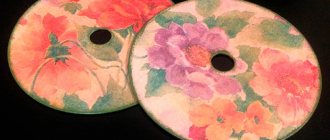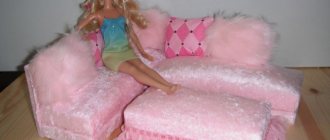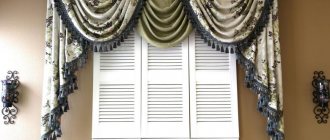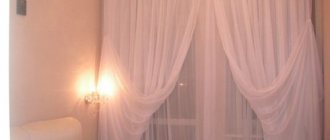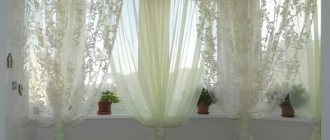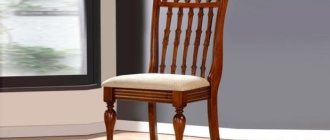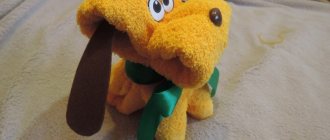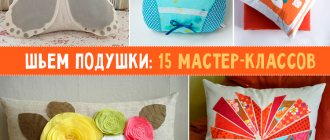Lambrequin is an elegant design element that will decorate and transform any room. Therefore, many craftswomen won’t mind learning how to sew a lambrequin with their own hands?
When creating a new interior in her room, any housewife pays great attention to the windows. It’s good when the window is designed to match the entire room. Lambrequins add a special charm to any room. But purchased products are too expensive. Therefore, many needlewomen learn to sew such products with their own hands. And I must say that they turn out no worse than store-bought ones. You just need to stock up on materials and patience for the process.
Preparatory stage
In the question of how to sew a lambrequin with your own hands of a narrow sample, detailed instructions will help, you should immediately notice the fact that even a beginner can cope with the work.
First of all, a pattern is created, the algorithm of actions is simple, it looks like this:
- On a sheet of paper you need to draw a horizontal line, which will be fixed to the cornice and will serve as a guide.
- The width and footage of the swag are calculated.
- Then we move on to calculating the arc length.
- Attention is paid to the cascade; the visual design of the folds and their drapery will depend on this decision.
- Start cutting out the blanks.
With some types of fabric, you need to be as careful as possible at the preparation stage, because awkward movements will inevitably stretch the thin structure or cause damage.
Making a pattern
First, you can prepare a pattern on a small scale, and then transfer it to the fabric in the required proportions.
Lambrequin pattern with dimensions:
- For a single-section product, take a length equal to the length of the cornice.
- If the product consists of two parts, then one overlaps the other by one third.
- When choosing a three-section product, you need to perform the following calculation: the length of the rod is divided by 7 and multiplied by 3. Each section must be equal to the length of the resulting indicator. For example, the length of the cornice is 180 cm: 180:7×3=77. Each cut should be equal to 77 cm. Each element should overlap the other by 1/3.
With more elements, the folds will begin to break, and the appearance of the drapery will not be so neat.
If in the chosen model the swags do not overlap each other, then the space between them is decorated with small decorative elements - a mold (decoration from a strip of fabric cut in a spiral), ties, bells. In this way, you can hide the cords formed when the parts are pulled into folds.
Product patterns should be drawn on a wall or large table.
Tooling and stitching material
Among the basic accessories for creating a lambrequin with your own hands for beginners, it is worth highlighting:
- Sharp scissors.
- Centimeter tape for measurements.
- Enough paper to make a pattern.
- Chalk or small bar of soap for tailoring.
- Large square.
Once all the pieces are cut, you need to trim the edges with bias tape, otherwise the appearance will be ugly. The prepared table should be well lit; it is better to allocate as much free space as possible for the convenience of the process.
The components of the future masterpiece are laid out on the surface and the planned folds are highlighted. The formed elements must be “baited”; after control fitting, all blanks are sewn together and attached to the rail.
Sewing
The process of sewing lambrequins consists of the following order of work:
- A square piece of fabric is folded twice diagonally in succession to determine the center of the swag.
- To create an assembly, use a regular plank, on which marks the arms of the arc and its middle are marked.
- The fabric is placed on the bar with a sag at an angle of 45°, the middle marked on the swag fabric should coincide with the mark on the beam.
- Once the folds are in place, they are secured with pins on both sides.
- Excess fabric is trimmed with scissors.
- The edges along the intended lines are drawn on both sides.
- After this, the material can already be removed from the bar.
- The finished arc can be decorated with any decorative element: fringe, bugle beads.
- The top of the swag is trimmed with curtain tape.
Common materials for work
Looking at numerous photos of self-made lambrequins, the question arises as to what raw materials are best used in the process.
The purchase of material should be approached seriously, because decorative elements should not lose their shape and become a decoration, and not cause surprise from the unsuccessful design of the home.
Flowing foundations such as:
- Veil.
- Semi-organza.
- Linen.
- Curtain fabrics.
For decorative work in the living room, experts advise using denser types of fabric; such additions much better emphasize the status of the owner. At the time of purchase, it will not be superfluous to pre-lay out the folds; this will help you avoid miscalculation in size.
When choosing a fabric with a pattern, you need to pay attention to the shade; it should be combined with the rest of the contents in the room.
Important! Professional tailors do not recommend purchasing ordinary organza for such decorative purposes. The material is very hard and it will not be possible to create smooth lines, which will certainly spoil the final appearance.
Kinds
There are several types of lambrequins.
Simple
This is a piece of fabric that is placed into a gather on a curtain tape. It has a simple or figured bottom edge. The first option on the curtain tape is simple, the second is swag (a hanging gathering of fabric). In order to sew the first option, you need to fold and sew the bottom and side seams, and attach a textile tape to the top edge. The bottom of the product can be decorated with an arch. It is pulled together with tape and attached to the cornice. The swag option is draped in a certain way; to do this, you need to create the correct line of folds so that the fabric is even.
Soft
For this look, light flowing fabrics are used. They drape beautifully and look soft and airy. Soft lambrequins can be combined in various ways, such as frills, bells, crossovers or swags. Ruffles, ribbons or fringes are used for decoration.
Hard
For this option you need to choose a very dense fabric. It is stretched onto a frame made of wood or glued to a non-woven base. The so-called bandeau lambrequin does not have any bends or folds; it perfectly holds its shape, which can also be of different types - round, straight, curly. For decoration you can use gold embroidery, tassels, cords or flowers.
Figured
This is a beautiful decorative element reminiscent of lace. The openwork pattern can be made using a stencil and burned using laser equipment.
Combined
The combination of hard and soft types of lambrequin allows you to create original models. As a rule, they use 3 or more drapery elements. The main condition is not to overload the design with unnecessary details.
Using a veil
The raw materials are quite popular, which is why it is better to find out as much existing information as possible about such lambrequins for curtains with your own hands, long before starting work on the creation.
- The material is quite light and folds can be draped without any problems; it is important to correctly calculate the volume of the fabric; at this stage it is worth considering the type of curtain and how many sections it will contain.
- A simple type of product will require adding 15 to 20 cm to the length on each side. Elements with one section when created should have a value multiplied by 1.5 times.
- The pattern begins only after cutting the paper blanks, the dimensions must fully correspond to the natural size, taking into account all the small nuances it will be possible to create ideal proportions.
What to sew from
Fashion trends extend to both lambrequins and other textile products. So, in the new season, it is preferable to opt for materials in pastel shades with a noble texture and a simple cut. Discreet and laconic decor will advantageously emphasize the elegance of flowing curtains.
For heavy, thick curtains, the following are suitable:
- jacquard;
- linen;
- cotton;
- atlas;
- plush;
- velvet.
They will add elegance and respectability to the design of the window opening.
For light and flowing curtains, the following are preferred:
- silk;
- taffeta;
- polyester;
- organza.
They will create a feeling of airiness and add grace to the interior of the room.
It is necessary to select material for curtains and lambrequins based on the style of the living space. For the living room, you can choose noble velvet or shiny jacquard; for the bedroom, linen and satin would be an excellent solution; for the kitchen, linen, cotton and polyester are ideal. These materials are practical and beautiful, especially when choosing the Provence style.
Working with hard fabrics
The process is more complex; before you start making openwork lambrequins with your own hands, you should practice on light samples.
- But if you have the right pattern, there shouldn’t be any problems; thanks to such auxiliary materials, beginners can feel more confident. Do not forget about the allowance for tucking the fabric; it is left on both sides of the cornice when measuring; 10 cm will be quite enough for further manipulations.
- At the top, the base is created smooth, and the bottom is designed in one of the styles, which you will be able to familiarize yourself with while viewing master classes or photos of finished structures.
To transfer the pattern, fabric with an adhesive base is purchased, at this point allowances of 2-3 cm are left, then the two elements are fastened with pins or small needles to give strength.
Recommendation! When forming the base, fabric allowances are not needed; such manipulations are performed only with the outer fabric in order to make the appearance attractive by tucking.
What is swag?
Those who are faced with the process of choosing new curtains for the first time often ask the question “What is swag?” Swag is one of the elements that can be used to decorate curtains, namely an addition to the lambrequin (its upper part); it is draped in a special way. It looks like a semicircle with folds on it. It consists of a head and shoulders (some call them wings).
Curtains can look like a real work of art if swags are used to create them.
Depth is the degree of its sagging, length is the length that this element occupies on the cornice. Next comes the middle part - the middle along the cornice. The shoulder is the part with drapery folds and other fabrics. Even when preparing a pattern, you come across the concept of “sag” (the third name is “depth”), this is the length by which the lower part can fall from the upper. Usually the difficulty is in arranging them correctly, but if done correctly, they will become a real highlight in the style of your room.
If you imagine exquisite, expensive curtains, then most likely they will be decorated with a lambrequin with swags.
Swag is used as a decorative component when sewing elegant and luxurious curtains.
Final stage
To ensure that the fabric sticks to the base as reliably as possible, use an iron heated to a certain temperature and iron the surface with it.
Using step-by-step instructions, you can avoid a lot of awkward situations; such manuals should be studied in advance, and the diagrams should be placed in front of you while working.
It is necessary to cut out the lining material according to the sample, all layers of the decorative element are assembled into one masterpiece, and stitched on a sewing machine.
It is important to remember that specimens with a rounded shape must have notches, otherwise the canvas will begin to form unplanned folds. This technique is performed from the inside of the device, which performs a decorative function.
Application in the interior
Initially, swags were used only for ceremonial premises. But they are so beautiful that they gradually migrated to ordinary houses. These decorations look best in a classic interior, where they complete a pompous image.
This model can also have asymmetrically laid shoulders.
Here it would be appropriate to use additional elements: fringe, lining, rhinestones. Swags will add romanticism to a room in Provence style. A product made of thin, translucent fabrics will look beautiful.
Curtains can be made even more unusual and original if you use the technique of transition to de jabot.
For the Art Nouveau style, products with a rectangular pattern of ascetic design are suitable. Scandinavian-style rooms will be decorated with multi-layered models made from fabrics of different textures - from velvet to transparent tulle. This will create an unusual play of light on the window.
Such curtains can really significantly diversify the interior.
For high-tech, you can also create stylish swags. Here it is better to choose a stiff fabric that forms creases instead of folds. This will give a complete look and an unusual look to the window.
Photos of homemade lambrequins
Gallery
Did you like the article? Subscribe to our Yandex.Zen channel
Great article 0
Curtains for the kitchen
The simplest curtains can be sewn for the kitchen . The main thing is that they are in harmony with the overall interior, that they are light, light, and “cheerful.”
The most practical material for the kitchen is polyester. Many housewives choose organza or tulle.
A fashionable novelty for decorating a kitchen window is the presence of blinds and the absence of curtains. This option is still unusual, but you can always add some zest to window decoration. Asymmetry is a great solution.
The solar curtain will fill the entire kitchen space with warmth. The easiest way to decorate a window:
- Attach the cornice.
- Cut two pieces of fabric and fold them on all sides.
- Sew loops to the top.
- Stretch a fabric of a different color from above, leaving a beautiful drapery on each side of the window.
